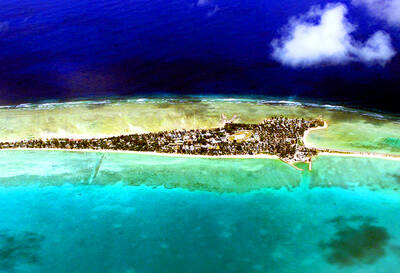Young people across Asia are struggling to find good jobs, with many stuck in low-productivity work that the World Bank said could strain social stability as frustrations fuel a global wave of youth-led protests.
The bank highlighted a persistent gap between younger and more experienced workers across several Asian economies in a regional economic update released yesterday, noting that one in seven young people in China and Indonesia are unemployed.
The share of people now vulnerable to falling into poverty is now larger than the middle class in most countries, it said.

Photo: Bloomberg
“The employment rate is generally high, but the young struggle to find jobs,” the World Bank wrote, adding that most people in Asia “who look for work find it.”
However, “many individuals in the region are in low-productivity or informal jobs,” it said.
Labor force participation remains low in Pacific nations and among women, with about a 15 percentage-point gap compared with men in Indonesia, Malaysia and the Philippines, it said.
The report also found that much of the region’s job growth has shifted from manufacturing to low-wage services, eroding gains that once lifted millions out of poverty.
Governments across Africa and Asia have been grappling with a surge of Gen Z-led demonstrations in the past few months, with thousands taking to the streets in the Philippines, Morocco, Madagascar, Indonesia, East Timor, Kenya and Mongolia to protest corruption, joblessness and widening inequality. The demonstrations, fueled by anger over lavish displays of wealth by ruling elites, have targeted governments — toppling administrations in Nepal and Bangladesh.
A closer look at the numbers in Asia shows that the unemployment rates of those aged 15-24 are more than 10 percent in places like Mongolia, Indonesia and China, while the rate among prime-aged workers aged 25-54 is 5 percent or lower, World Bank data showed.
Firms that are five years old or less play an out-sized role in job creation, the bank said.
In Malaysia and Vietnam for example, they account for 57 percent of total employment, but contribute 79 percent of job creation, and yet their role has been dampened because fewer new firms are entering markets, the report said.
Trade has boosted jobs in countries such as Cambodia and Vietnam, though gains remain uneven and vulnerable to global shocks, it said.
“Countries are not fully realizing the benefits of moving workers from less to more productive sectors and firms,” the World Bank said.

DISASTER: The Bangladesh Meteorological Department recorded a magnitude 5.7 and tremors reached as far as Kolkata, India, more than 300km away from the epicenter A powerful earthquake struck Bangladesh yesterday outside the crowded capital, Dhaka, killing at least five people and injuring about a hundred, the government said. The magnitude 5.5 quake struck at 10:38am near Narsingdi, Bangladesh, about 33km from Dhaka, the US Geological Survey (USGS) said. The earthquake sparked fear and chaos with many in the Muslim-majority nation of 170 million people at home on their day off. AFP reporters in Dhaka said they saw people weeping in the streets while others appeared shocked. Bangladesh Interim Leader Muhammad Yunus expressed his “deep shock and sorrow over the news of casualties in various districts.” At least five people,

ON THE LAM: The Brazilian Supreme Court said that the former president tried to burn his ankle monitor off as part of an attempt to orchestrate his escape from Brazil Former Brazilian president Jair Bolsonaro — under house arrest while he appeals a conviction for a foiled coup attempt — was taken into custody on Saturday after the Brazilian Supreme Court deemed him a high flight risk. The court said the far-right firebrand — who was sentenced to 27 years in prison over a scheme to stop Brazilian President Luiz Inacio Lula da Silva from taking office after the 2022 elections — had attempted to disable his ankle monitor to flee. Supreme Court judge Alexandre de Moraes said Bolsonaro’s detention was a preventive measure as final appeals play out. In a video made

It is one of the world’s most famous unsolved codes whose answer could sell for a fortune — but two US friends say they have already found the secret hidden by Kryptos. The S-shaped copper sculpture has baffled cryptography enthusiasts since its 1990 installation on the grounds of the CIA headquarters in Virginia, with three of its four messages deciphered so far. Yet K4, the final passage, has kept codebreakers scratching their heads. Sculptor Jim Sanborn, 80, has been so overwhelmed by guesses that he started charging US$50 for each response. Sanborn in August announced he would auction the 97-character solution to K4

SHOW OF FORCE: The US has held nine multilateral drills near Guam in the past four months, which Australia said was important to deter coercion in the region Five Chinese research vessels, including ships used for space and missile tracking and underwater mapping, were active in the northwest Pacific last month, as the US stepped up military exercises, data compiled by a Guam-based group shows. Rapid militarization in the northern Pacific gets insufficient attention, the Pacific Center for Island Security said, adding that it makes island populations a potential target in any great-power conflict. “If you look at the number of US and bilateral and multilateral exercises, there is a lot of activity,” Leland Bettis, the director of the group that seeks to flag regional security risks, said in an